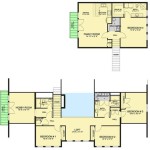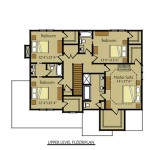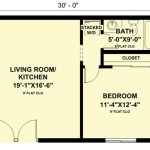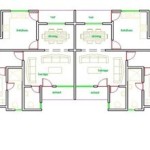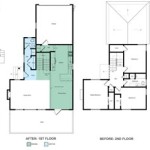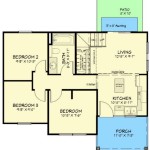One-Story House Plans for Narrow Lots: Optimizing Space and Style
Building a home on a narrow lot presents unique design challenges. Limited width requires careful planning to maximize usable space and create a comfortable living environment. One-story house plans, also known as ranch-style homes, offer several advantages for narrow lot construction. These plans can effectively utilize the available land, providing accessible living spaces and efficient designs that cater to various lifestyle needs. This article explores the key considerations, design elements, and advantages of one-story house plans tailored for narrow lots.
Narrow lots are generally defined as plots of land with limited frontage, restricting the width available for building. These lots are commonly found in urban areas, infill development projects, and densely populated suburban environments. The restricted dimensions demand innovative design strategies to ensure functionality, aesthetics, and compliance with local building codes and zoning regulations. One-story house plans can be particularly effective in addressing these limitations by focusing on horizontal space utilization and integrated design elements.
Before selecting a specific plan, conducting thorough site analysis is crucial. This analysis should encompass several factors, including lot dimensions, orientation, topography, soil conditions, existing utilities, and local zoning ordinances. Understanding these constraints and opportunities will inform the design process and ensure that the chosen plan is feasible and compliant. Furthermore, it is important to consider the neighborhood context and architectural style to maintain harmony with the surrounding environment.
Key Considerations for Narrow Lot Design
Designing a one-story house plan for a narrow lot necessitates a focus on efficient space utilization, natural light optimization, and privacy considerations. The limited width requires strategic planning to create functional living areas without compromising comfort or aesthetics. Several key factors should be considered during the design phase.
Firstly, circulation paths within the house should be minimized. Long, winding hallways waste valuable square footage and can make the house feel cramped. Open floor plans, where living spaces flow seamlessly into one another, can create a sense of spaciousness and improve overall functionality. Strategic furniture placement and the use of visual dividers, such as area rugs or changes in flooring, can define distinct zones within the open plan without sacrificing the feeling of openness.
Secondly, natural light is essential for creating a bright and inviting atmosphere in a narrow house. Large windows and strategically placed skylights can maximize natural light penetration. Consider the orientation of the house on the lot to optimize solar gain during the colder months and minimize excessive heat during the summer. Light-colored interior finishes and reflective surfaces can further enhance the diffusion of natural light throughout the house.
Thirdly, privacy is a significant concern when building on a narrow lot, especially in close proximity to neighboring properties. The design should incorporate elements that enhance privacy without blocking natural light or airflow. Strategically placed windows, landscaping, and fencing can create a buffer between the house and its neighbors. Internal courtyards or atriums can also provide private outdoor spaces while allowing natural light to enter the interior of the house.
Finally, consider the use of vertical space even in a one-story design. High ceilings can create a sense of spaciousness and allow for the incorporation of taller windows for increased natural light. Storage solutions can also benefit from maximizing vertical space, such as floor-to-ceiling shelving units or built-in cabinets.
Advantages of One-Story House Plans on Narrow Lots
One-story house plans offer several advantages when constructing a home on a narrow lot. These advantages include accessibility, cost-effectiveness, and ease of maintenance. The absence of stairs makes one-story homes particularly suitable for individuals with mobility challenges, families with young children, and aging homeowners. Furthermore, one-story construction can often be more cost-effective than multi-story construction due to simplified framing and reduced material requirements.
One of the primary advantages is accessibility. The lack of stairs eliminates the need for elevators or stairlifts, making the home easily navigable for individuals with mobility limitations. This is particularly important for aging in place, allowing homeowners to remain in their homes comfortably and safely as they age. One-story homes are also safer for young children, reducing the risk of falls on stairs.
Cost-effectiveness is another significant benefit. Building a one-story home typically requires less framing material, as there are no load-bearing walls for upper floors. Foundation costs can also be lower, as the foundation only needs to support the weight of a single story. Additionally, the construction process is often simpler and faster, potentially reducing labor costs. Heating and cooling costs can also be lower in a well-designed one-story home, as heat rises and is easily lost through the roof in multi-story structures.
Maintenance is also simplified in one-story homes. Exterior maintenance, such as painting, cleaning gutters, and repairing roofs, is easier and safer to perform without the need for ladders or scaffolding. Interior maintenance is also easier, as all living spaces are on a single level. This can be particularly beneficial for older adults or individuals with physical limitations.
Furthermore, one-story house plans can be easily adapted to incorporate universal design principles. Universal design focuses on creating homes that are accessible and usable by people of all ages and abilities. This includes features such as wider doorways, grab bars in bathrooms, and lever-style door handles. Implementing universal design principles can enhance the comfort, safety, and long-term value of a one-story home on a narrow lot.
Design Elements for Optimizing Narrow Lot House Plans
Several design elements can be incorporated into one-story house plans to optimize space utilization, enhance natural light, and create a comfortable living environment on a narrow lot. These elements include open floor plans, strategic window placement, integrated outdoor spaces, and efficient storage solutions.
Open floor plans are essential for creating a sense of spaciousness in a narrow house. By eliminating walls between living areas, such as the living room, dining room, and kitchen, the house feels larger and more connected. This also allows for better circulation and natural light distribution. Consider defining distinct zones within the open plan using furniture placement, area rugs, or changes in flooring.
Strategic window placement is crucial for maximizing natural light penetration and creating a bright and inviting atmosphere. Large windows should be placed on exterior walls to capture as much sunlight as possible. Skylights can also be used to bring natural light into interior spaces that do not have access to exterior walls. Consider the orientation of the house to optimize solar gain during the winter and minimize excessive heat during the summer. Window treatments, such as blinds or curtains, can be used to control the amount of sunlight entering the house.
Integrated outdoor spaces can extend the living area and create a seamless connection between the interior and exterior. Patios, decks, and courtyards can provide additional living space for relaxation, dining, and entertaining. Consider incorporating landscaping elements, such as trees and shrubs, to create privacy and enhance the aesthetic appeal of the outdoor spaces. Outdoor living spaces can be particularly valuable on narrow lots, where interior space may be limited.
Efficient storage solutions are essential for maximizing space utilization in a narrow house. Built-in cabinets, shelving units, and closets can provide ample storage without taking up valuable floor space. Consider utilizing vertical space by installing floor-to-ceiling storage units. Multifunctional furniture, such as storage ottomans or sofa beds, can also help to maximize space utilization. A well-designed storage system can help to keep the house organized and clutter-free, creating a more comfortable and functional living environment.
In conclusion, building a one-story home on a narrow lot requires careful planning and innovative design strategies. By considering the key factors outlined in this article, homeowners can create functional, stylish, and comfortable living spaces that maximize the potential of their limited land. From efficient space utilization to natural light optimization and privacy considerations, a well-designed one-story house plan can offer a multitude of advantages for narrow lot construction.

Contemporary One Story House Plan Suitable For A Narrow Lot 65740bs Architectural Designs Plans

Plan 42593db One Story House For The Narrow Lot

Narrow Lot Floor Plan For 10m Wide Blocks Boyd Design Perth

House Plan 77017 One Story Style With 1434 Sq Ft 3 Bed 2 Bath Coolhouseplans Com

House Plan 55865 One Story Style With 1902 Sq Ft 4 Bed 3 Bath Coolhouseplans Com

Plan 22526dr Narrow Lot Ranch House

Cottage Bungalow Plans Simple 2 Bedroom For A Narrow Lot

Tarpon Springs Narrow Lot Home Plan 047d 0001 House Plans And More

Narrow Lot House Plan 9745

Mediterranean House Plan One Story Home Floor For Narrow Lot

